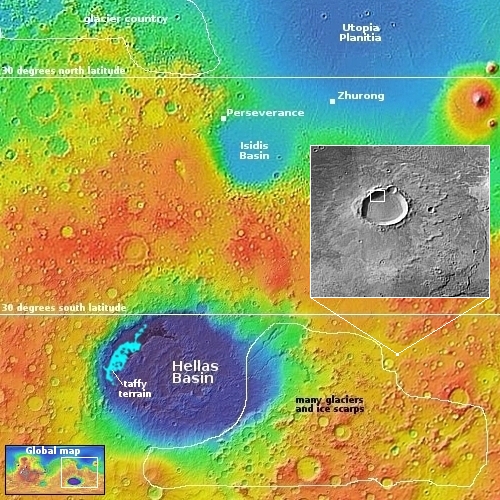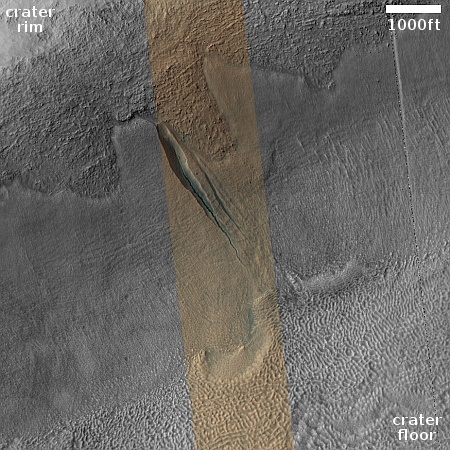Distinct gully draining the side of a Martian crater
Cool image time! The picture to the right, cropped, reduced, and sharpened to post here, was taken on August 20, 2024 by the high resolution camera on Mars Reconnaissance Orbiter (MRO). The science team labels the entire picture simply as “gully,” obviously referring to that distinct and somewhat deep hollow in the middle of the picture.
Most gullies that have been found on Mars tend to look more eroded and rougher than this hollow. Here, it appears almost as if the process that caused this gully occurred relatively recently, resulting in its sharp borders that have not had time to crumble into softer shapes.
The crater interior slope is about 1,500 feet high. Whatever flowed down it however did not do it in an entirely expected manner. As it flowed it curved to the west, so that the impingement into the glacial material that fills the crater floor is to the west of the gully itself. Either that, or that impingement was caused by a different event at a different earlier time.

The white dot on the overview map to the right marks the location, about 800 miles east of Hellas Basin and just outside a region that researchers have marked as containing a lot of glaciers and near-surface ice features. This unnamed seven-mile-wide crater however has such features in it, suggesting that glacier region is larger than presently mapped. Moreover, the crater is at 38 degrees south latitude, well inside the mid-latitudes where many glacial features are seen routinely on Mars.
The splash apron surrounding this crater, as shown in the inset, provides more evidence that there is a lot of near surface ice here. The glacial features on the crater’s floor add further weight to this assumption.
The gully is on a pole-facing slope, which means it gets more sunlight year round. That extra light could explain the gully formation. Sunlight heated the ground, causing any impregnated ice to sublimate into vapor. In doing so, it caused a burst that resulted in the gully. That much of the material from that gully was water that turned into gas explains why there is so little avalanche debris at the gully’s base. It has largely turned into cold steam.
On Christmas Eve 1968 three Americans became the first humans to visit another world. What they did to celebrate was unexpected and profound, and will be remembered throughout all human history. Genesis: the Story of Apollo 8, Robert Zimmerman's classic history of humanity's first journey to another world, tells that story, and it is now available as both an ebook and an audiobook, both with a foreword by Valerie Anders and a new introduction by Robert Zimmerman.
The print edition can be purchased at Amazon or from any other book seller. If you want an autographed copy the price is $60 for the hardback and $45 for the paperback, plus $8 shipping for each. Go here for purchasing details. The ebook is available everywhere for $5.99 (before discount) at amazon, or direct from my ebook publisher, ebookit. If you buy it from ebookit you don't support the big tech companies and the author gets a bigger cut much sooner.
The audiobook is also available at all these vendors, and is also free with a 30-day trial membership to Audible.
"Not simply about one mission, [Genesis] is also the history of America's quest for the moon... Zimmerman has done a masterful job of tying disparate events together into a solid account of one of America's greatest human triumphs."--San Antonio Express-News
Cool image time! The picture to the right, cropped, reduced, and sharpened to post here, was taken on August 20, 2024 by the high resolution camera on Mars Reconnaissance Orbiter (MRO). The science team labels the entire picture simply as “gully,” obviously referring to that distinct and somewhat deep hollow in the middle of the picture.
Most gullies that have been found on Mars tend to look more eroded and rougher than this hollow. Here, it appears almost as if the process that caused this gully occurred relatively recently, resulting in its sharp borders that have not had time to crumble into softer shapes.
The crater interior slope is about 1,500 feet high. Whatever flowed down it however did not do it in an entirely expected manner. As it flowed it curved to the west, so that the impingement into the glacial material that fills the crater floor is to the west of the gully itself. Either that, or that impingement was caused by a different event at a different earlier time.

The white dot on the overview map to the right marks the location, about 800 miles east of Hellas Basin and just outside a region that researchers have marked as containing a lot of glaciers and near-surface ice features. This unnamed seven-mile-wide crater however has such features in it, suggesting that glacier region is larger than presently mapped. Moreover, the crater is at 38 degrees south latitude, well inside the mid-latitudes where many glacial features are seen routinely on Mars.
The splash apron surrounding this crater, as shown in the inset, provides more evidence that there is a lot of near surface ice here. The glacial features on the crater’s floor add further weight to this assumption.
The gully is on a pole-facing slope, which means it gets more sunlight year round. That extra light could explain the gully formation. Sunlight heated the ground, causing any impregnated ice to sublimate into vapor. In doing so, it caused a burst that resulted in the gully. That much of the material from that gully was water that turned into gas explains why there is so little avalanche debris at the gully’s base. It has largely turned into cold steam.
On Christmas Eve 1968 three Americans became the first humans to visit another world. What they did to celebrate was unexpected and profound, and will be remembered throughout all human history. Genesis: the Story of Apollo 8, Robert Zimmerman's classic history of humanity's first journey to another world, tells that story, and it is now available as both an ebook and an audiobook, both with a foreword by Valerie Anders and a new introduction by Robert Zimmerman.
The print edition can be purchased at Amazon or from any other book seller. If you want an autographed copy the price is $60 for the hardback and $45 for the paperback, plus $8 shipping for each. Go here for purchasing details. The ebook is available everywhere for $5.99 (before discount) at amazon, or direct from my ebook publisher, ebookit. If you buy it from ebookit you don't support the big tech companies and the author gets a bigger cut much sooner.
The audiobook is also available at all these vendors, and is also free with a 30-day trial membership to Audible.
"Not simply about one mission, [Genesis] is also the history of America's quest for the moon... Zimmerman has done a masterful job of tying disparate events together into a solid account of one of America's greatest human triumphs."--San Antonio Express-News


